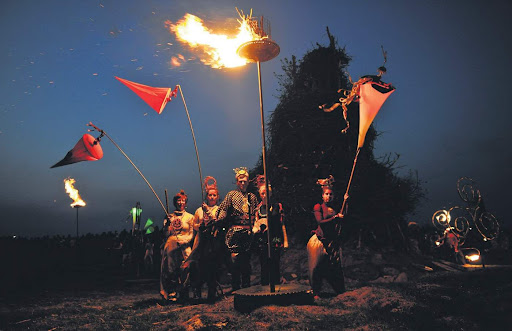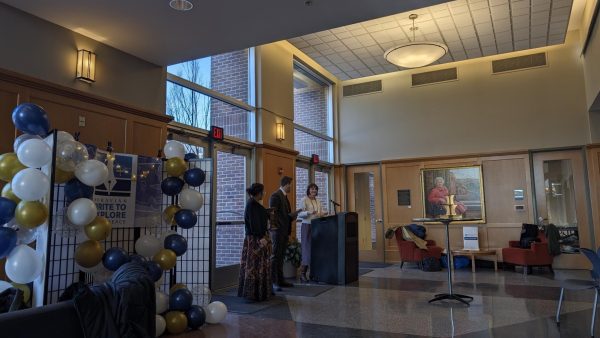The Ancient Origins of Halloween

From independent.ie
It marks the end of the harvest and the beginning of the “Dark Days”. Samhain night, the eve of 31 October into 1 November, was said to be the night where the veil between this world and the Other World, that is the domain where the Faerie folk and Tuatha de Danann (Too+ah+uh day Dahn+in) who once roamed Ireland freely, were forced into. Several places around Ireland were said to be portals to these Otherworlds. Samhain is a Fire Festival, one of the most important celebrations in the Irish tradition. It was not a celebration of darkness but rather of light and life. It was a time of remembrance and thankfulness as the darkness approached, and practices of the festival were intended to keep the light alive.
Two places stood out to the Ancient Irish as portals greater than any other. One was at The Hill of Tara, where the High King of Ireland would eventually sit and rule from, and it was at these two locations on opposing sides of the country that it is said Samhain began.
At Tara, in County Meath, the people of the surrounding villages made a trek one mile from town up to the top of the hill where they would light a great fire with intentions of warding away the Faeries said to come through the portal and into the mortal world. The fire and its light was said to capture the Spirits of the wandering dead and of the Faeries and send them back to the Otherworld once more. This practice of lighting fires on Samhain became commonplace all throughout Irish history.
Across the country, similar practices began outside the stone age city of the Rathcroghan, the capital city of the Western Kingdom, Connacht. The site was a cave known as Uaimh na aGcat (Oh+Wi+Nah+Got), the Cave of Cats. This portal in particular was said to lead directly to the domain of the Ancient Irish goddess of war, death, and fate, The Great Phantom Queen herself, The Morrígan (Mor+ree+gun). Here, it was said she would unleash her Faeries, who were viewed similarly to Demons in later Christian perspectives, onto the mortal world in order to steal human souls and exact her revenge on the mortals who forced her and the other Tuatha de Danann underground.
Trick or Treating was a tradition first birthed during the middle ages, but has a basis far earlier. From soul cakes and costumes to prayers for the souls of those passed, Trick or Treating itself has a rather curious history.
The people, in fear of The Morrígan and her Faeries, began several traditions. One included dressing up children to disguise them and trick the Faerie folk into thinking the human children were of their own and thus not take them to the Otherworld. Some suggestions also exist of practices of human sacrifice, involving a spiced honey cake called a Soul Cake, though this practice, in connection with the cakes, is highly contested. What the ancient Soul Cakes were intended for is up for debate.
In the 11th century CE, the practice of “modern day” Trick or Treating came about. Much different from the earlier pagan traditions, this one came with the development of Christianity in Ireland. Families were encouraged to open their homes up on All Hallows Eve and the poor of the town could come to beg at the doorsteps of their neighbours. In return for the food they received, they would pray for the souls of the departed from that family. In some earlier cases, a trick or task could be performed in return for a cake similar to the ancient Soul Cakes.
Many stories of light exist within the narrative of Samhain and in turn, of Halloween. Such is the tale of Stingy Jack of the Lantern.
A long time ago, there lived a man named Jack. Due to his nature of lying, swindling, scamming and well, being stingy, he became known as Stingy Jack. One day, Jack found himself in a pub when in came a traveller. This traveller was the Devil himself and he had come to collect Jack and bring him to Hell. Jack offered him a drink and soon they were enjoying several rounds of drinks and a merry conversation ensued. After an enjoyable night, Jack said to the Devil that he should turn into a coin so as to pay for the drinks. So the Devil complied and transfigured himself into a coin. Rather than using the coin to pay, however, he took the coin and put it in his pocket, covering it with a crucifix, thus preventing the Devil’s escape. He told the Devil he would only release him if the Devil promised to not come for him for another ten years. The devil agreed and so Jack released him and the two parted ways.
Ten years passed and the Devil again came to collect Jack. Jack said he would gladly go with the Devil, but first requested an apple from a nearby tree. He asked the Devil to get it for him, so the Devil climbed the tree to pick an apple. Again, Jack had tricked him! He placed crucifixes all around the base of the tree and so the Devil again was trapped. Jack this time said he would only release the Devil on the terms the Devil would never claim his soul. The Devil promised. Jack released him.
The two once more parted ways. Well, some time passed and Jack died of natural causes. He went to Heaven’s gates and requested entry, but because of his awful reputation in life and very long list of sins, God denied him entry. Jack found himself at the gates of Hell… But keeping his word, the Devil reminded Jack that they had made a deal, that Jack would never have his soul claimed by the Devil.
So, the Devil cursed Jack to eternal purgatory, giving him an ember from the Hellfire to light his way through the eternal darkness. Jack fashioned himself a lantern for the ember by carving a face into a turnip. It is said that Jack would find his way to the villages and continue to swindle the townsfolk of Ireland. They placed their own carved turnips out on their doorsteps to confuse Jack and to ward off other spirits and Faerie folk. Jack became known as Jack of the Lantern, later Jack O’ Lantern, keeper of the light to guide through the darkness.











